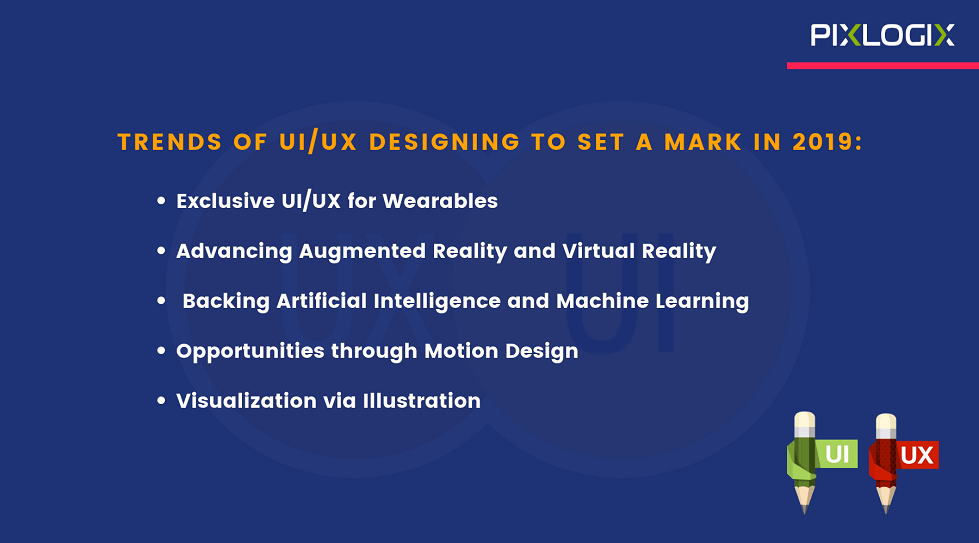User experience (UX) has become a priority for developing the scalability of any product; this is how most businesses will grow in the future. On the other hand, User interface (UI) not only fulfills the aesthetical requirements of the targeted users but also provides them a better level of usability.
You would risk and lose your users if they don’t like your product in the first glance. UI is essentially the first thing that your users will see, before getting their hands dirty to explore your work.

So, it’s wise to be ready with the below-mentioned trends of UI/UX designing to set a mark in 2019.
Exclusive UI/UX for Wearables
In the last year or so, we have come across the popularity of diverse types of wearables. Starting with smartwatches and devices to track your fitness or heart rate, they have impacted the users. And their recognition will keep on rising in 2019. So, it’s up to the UI/UX designer to polish the user interface and users experience of these devices. It’s a tempting domain for designers to work at the meeting point of technology, fitness, and wellness.
Advancing Augmented Reality and Virtual Reality
Designers are going way beyond to screen the single interface to bring physical interactions for the users through AR and VR. The year 2019 is going to be a year where designers not only need to think out of the box, they have to figure out of the grid. Apple and Google already have AEKit and ARCore, which is the interaction between the real and digital world.
We are sure that as sufficient creators come into the AR and VR domain, there will be more opportunities to make and examine fresh UI designs, assisting the industry in moving further ahead.
Backing Artificial Intelligence and Machine Learning
Machine intelligence and Artificial intelligence doesn’t automatically lead to intelligent UX/UI if product designers, as well as technology experts, don’t talk a similar language.
The concepts and language of these two technologies are far from instinctive. They will not replace UX/UI designers; however, they can work jointly to offer the users what they desire. It’s about corresponding user information that ML and AI gather with the know-how of UI/UX designers.
Opportunities through Motion Design
The growth of motion design technology has created an opportunity for animation by adding movement to your design. Leveraging motion design enables fluid navigation between different applications of UI design services.
The digital products these days intend to give a more futuristic and modern approach to the design outlook. Also, adding movement offers a story to the product. For every click, there is a transition that creates eagerness in the minds of the user to dig more. So, adding motion is an influential and visionary approach to notify a story.
Adding motion also guides the user on where to focus; it affects both their psychology and biology to interact positively, and magically brings their attention to wherever you want them to focus. Use WebGL; it’s a JavaScript library providing 3D graphics to bring interaction to your website.
Further, it’s vital to have a balance of the simplicity and consistency in the transition you make through UI. Else, the speed and time of change will ruin the whole experience and instead send a wrong message to the user.
Visualization via Illustration
It’s not only necessary to focus on just technology and forgetting the emotional quotient attached to a product. The illustration needs to be playful and speak for the product. It provides a visual interpretation of the whole concept and process. Adding illustrations make users understand and imagine the stuff better; as it directly triggers the required message across. Visuals transmit faster to the brain than the words. It also makes it globally more usable, making the interface universally acceptable.
So, now where to utilize them in UI? You can add them in the form of Infographics, statistical visuals, stickers, product’s mascot, in-mail messages, and gradient.
Moving ahead, the gradients have become unavoidable in this modern environment; they are taking their place back. Gradients blend one color to the other and provide the designer to create a new color altogether; this allows the objects to stand out. To sum up – it adds up the depth.
Additionally, gradients not only bring attention, but they add dimensions and depth to the User Interface and User Experience Solutions. The key is to take care of the clear light source. With the playful usage of different tones and depth creates a memorable user experience which stands-out. The only rule is not to overdo it.
Key Takeaways
It is essential for a leading UI/UX Design Company to become future-ready and make the interfaces flexible. And with this adaptability, they can accommodate the upcoming trends to stay ahead of the game in 2019.
